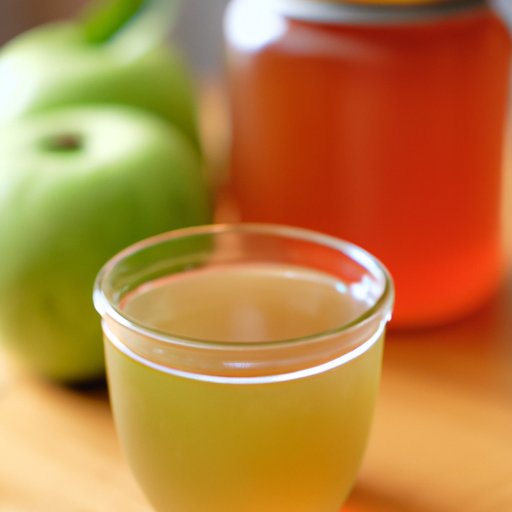
Introduction
Apples are one of the most popular fruits in the world, and apple juice is enjoyed by millions of people daily. While store-bought apple juice is widely available, it often contains added sugars and preservatives. Making fresh apple juice at home from locally sourced fruit is a simple and enjoyable process that yields a healthier and more flavorful beverage. In this article, we’ll take you through the step-by-step process of making homemade apple juice, discussing the benefits of fresh juice, common mistakes to avoid, techniques and equipment for juicing apples, and types of apples to use.
Step-by-Step Guide
To make delicious and nutritious apple juice, you’ll need a few essential ingredients:
– Fresh apples (any variety, depending on your preference)
– Water
– Sugar (optional)
Step 1: Washing and Preparing the Apples
Start by washing your apples, removing stems, bruises, and blemishes. Cut them into quarters to make them easier to juice. Be sure to remove any seeds as they can add a bitter taste to the juice.
Step 2: Cooking the Apples
Heat the apples and a cup of water in a pot over medium heat. The water will help soften the apples, making them easier to extract the juice. Cook the apples for 15-20 minutes until they are soft and mushy.
Step 3: Straining the Juice
Next, you’ll need to strain the juice from the apples. You can use a cheesecloth to create a mesh bag for the apples to sit in, and then squeeze the juice out with your hands. Alternatively, you can use a juicer or blender. Run the blended mixture through a fine sieve or cheesecloth to separate the juice and remove any pulp or solids.
Step 4: Sweetening and Storing the Juice
Add sugar to your taste, and mix the juice to ensure the sugar dissolves. You can store the apple juice in a glass bottle or jar in the refrigerator for up to 2-3 days.
Benefits of Making and Consuming Fresh Apple Juice
Making fresh apple juice at home has many advantages, including:
– It’s a healthier option since it doesn’t contain added sugars, preservatives, or flavors.
– You can customize the flavor to your preference by adding a variety of ingredients such as cinnamon, ginger, honey, and lemon juice.
– It’s a great way to use up excess apples and avoid food waste.
– Fresh apple juice is rich in antioxidants, vitamins, and minerals essential for optimal health.
Easy Flavors and Recipe Variations
To switch up the flavor of your apple juice, try adding vanilla extract, almond extract, or a pinch of salt, or blending it with other fruits such as strawberries or raspberries.
Nutritional Content Comparisons
Fresh apple juice has higher nutritional content than store-bought options. While some brands offer 100 percent apple juice, most contain added sugars and preservatives that lower its nutritional value. Making fresh juice from locally sourced apples means you’ll get the maximum nutritional benefit.
Common Mistakes and How to Avoid Them
Some common mistakes made when making apple juice include using unripe apples, not washing or preparing the apples correctly, or using too much sugar. Here are a few tips to avoid these mistakes:
– Use ripe apples that are in season for the freshest flavor.
– Wash and prepare your apples thoroughly to prevent any impurities from entering the juice.
– Taste the apple juice as you add sugar to avoid oversweetening.
Techniques and Equipment for Juicing Apples
There are various methods for juicing apples, each with its benefits, including:
– Handheld juicer – an affordable and simple solution for small quantities of apple juice.
– Blender – This is an easy way to blend the apples without any additional equipment.
– Centrifugal juicer – A more expensive option, but faster than the handheld juicer.
– Masticating juicer – Also called a cold press juicer, this method is the most effective way of extracting juice from apples, but it is also more expensive.
Before choosing your juicing method, consider factors like the amount of apples you need to juice, the time it takes to juice, and your budget.
Types of Apples for Juicing
Not all apples are created equal, and some types are better suited to making juice than others. Here are five types of apples that work great for juicing:
– Granny Smith – tart and crisp
– Honeycrisp– sweet and juicy
– Rome – large and slightly tart
– Golden Delicious – subtle sweetness
– Fuji – crisp and juicy
When making your apple juice recipe, consider using a mixture of different types of apples for a balanced flavor.
Nutritional Advantages of Fresh Apple Juice
Fresh apple juice provides many nutritional benefits, including:
– Vitamin C – essential for immune function and skin health
– Fiber – improves digestion and prevents constipation
– Calcium – strengthens bones and teeth
– Magnesium – necessary for muscle and nerve function
– Potassium – regulates blood pressure and promotes heart health
– Flavonoids – antioxidants that boost immune function
When apple juice is pasteurized, it loses some of these vital nutrients, especially vitamin C, potassium, and flavonoids.
Conclusion
Making fresh apple juice at home is a healthy, sustainable, and delicious option. With the right technique, equipment, and types of apples, you can create a nutritious beverage that’s perfect for any time of the day. By following this guide, you’ll learn how to avoid mistakes and customize the flavor of your juice. We encourage you to try making apple juice at home and enjoy its benefits while avoiding the drawbacks of store-bought juice.




